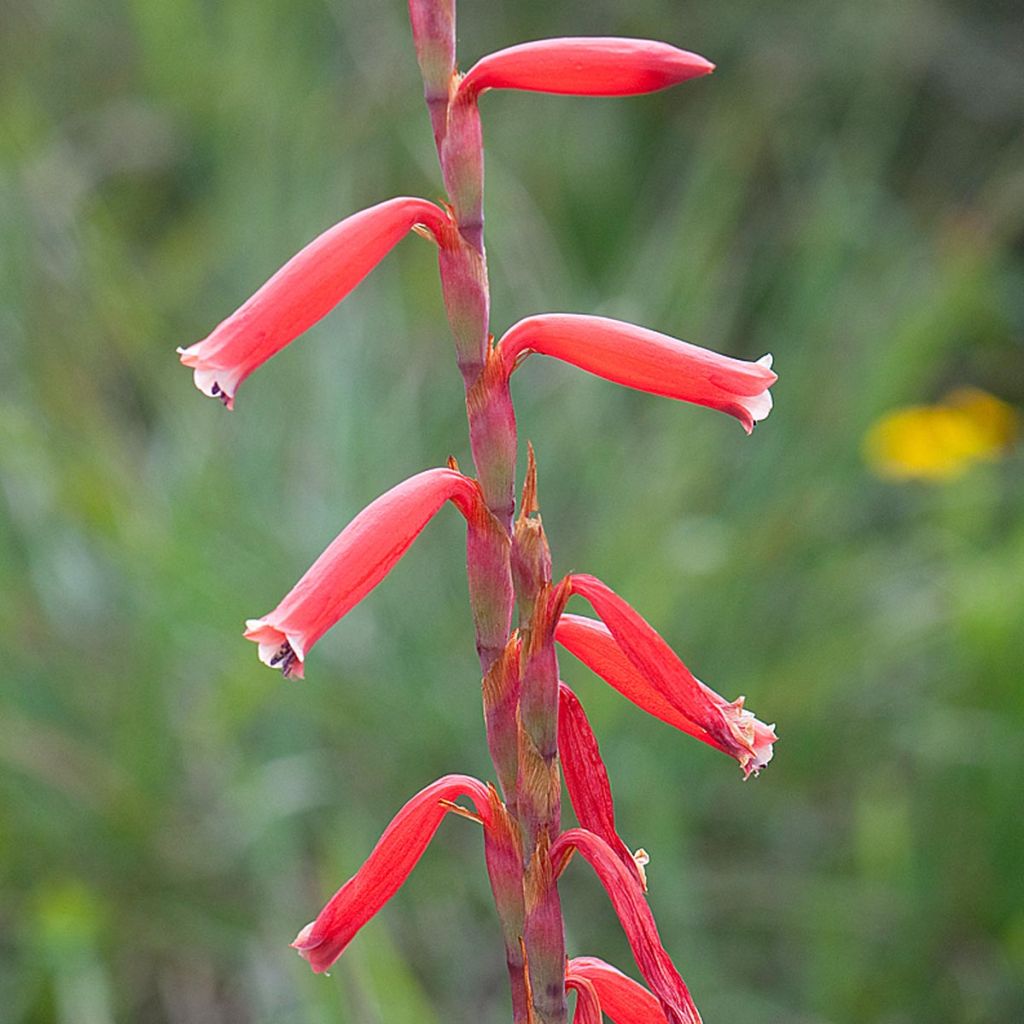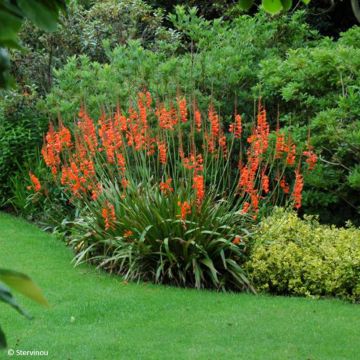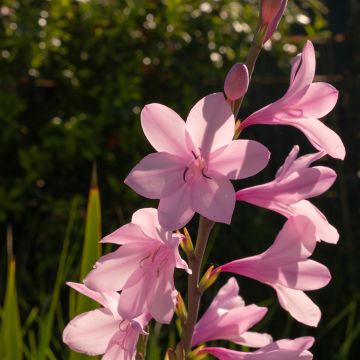

Watsonia aletroides - Watsonie faux-Alétris
Watsonia aletroides
Watsonia aletroides
Watsonia
This plant carries a 6 months recovery warranty
More information
We guarantee the quality of our plants for a full growing cycle, and will replace at our expense any plant that fails to recover under normal climatic and planting conditions.
From €5.90 for pickup delivery and €6.90 for home delivery
Express home delivery from €8.90.
Does this plant fit my garden?
Set up your Plantfit profile →
Description
Native to the Cape region in South Africa, Watsonia aletroides is a semi-hardy bulbous plant that bears spike-like inflorescences of tubular flowers in spring, with a vibrant shade that is intermediate between coral pink and shrimp pink. This plant has sword-shaped, glossy leaves reminiscent of Gladioli. It thrives in well-drained, light soil that is moist during the growing season and dry in summer, and prefers full sun.
Belonging to the Iridaceae family like Crocosmias, Schizostylis, and Dietes, Watsonia aletroides is a cormous plant with medium green, glossy foliage that resembles Gladioli leaves and reaches a height of 40cm (16in). In its native habitat, it grows on rocky slopes, high plateaus, and grassy slopes. From late spring to early summer, depending on the climate, it produces upright, unbranched inflorescences that are 60cm (24in) in height and adorned with a dozen elongated trumpet-shaped flowers. The flowers have a slightly upturned edge and are an indescribable translucent, shiny watermelon red-pink color. They measure 4 to 5cm (2in) in length and gently tilt towards the ground. When left to its own devices in a mild climate, the plant gradually forms beautiful clumps through the production of underground bulblets.
In the intense light of June, the inflorescences of Watsonia aletroides create original and highly colourful scenes. For a modern mass planting with exotic flair, mix your Watsonia aletroides bulbs with Kniphofias, Crocosmias, Libertias, and Carex. This plant is cultivated similarly to Gladioli, which are lifted after the foliage has turned yellow and then replanted in early spring. It also makes beautiful container displays for decorating a terrace or balcony.
Report an error about the product description
Plant habit
Flowering
Foliage
Botanical data
Watsonia
aletroides
Iridaceae
Watsonia
South Africa
Other Watsonia
Planting and care
Hardy down to -7, -8°C (17.6°F), Watsonia aletroides likes moist soils from September-October to May-June, and dry soils in summer. In its natural habitat, it is an accommodating plant that tolerates clayey and heavy soils, as long as they are dry in summer. It is a plant adapted to a Mediterranean climate, suited to summer drought which corresponds to its dormancy period. It primarily dislikes humid summers and winters that are both harsh and rainy. In colder regions, plant it facing south, on a sand dune, in a rockery or on a slope. When planting, replace your topsoil with pure sand to maximize drainage around the bulb. Store the bulbs in a box filled with turf and keep them in a dry, frost-free place. In Mediterranean regions, where winter frosts are not too severe, this Watsonia, planted deep (25 or 30cm (10 or 12in) deep to ensure good anchoring of the stems), can remain in the ground, in full sun, with regular watering if spring is dry.
Planting period
Intended location
Care
This item has not been reviewed yet - be the first to leave a review about it.
Haven't found what you were looking for?
Hardiness is the lowest winter temperature a plant can endure without suffering serious damage or even dying. However, hardiness is affected by location (a sheltered area, such as a patio), protection (winter cover) and soil type (hardiness is improved by well-drained soil).

Photo Sharing Terms & Conditions
In order to encourage gardeners to interact and share their experiences, Promesse de fleurs offers various media enabling content to be uploaded onto its Site - in particular via the ‘Photo sharing’ module.
The User agrees to refrain from:
- Posting any content that is illegal, prejudicial, insulting, racist, inciteful to hatred, revisionist, contrary to public decency, that infringes on privacy or on the privacy rights of third parties, in particular the publicity rights of persons and goods, intellectual property rights, or the right to privacy.
- Submitting content on behalf of a third party;
- Impersonate the identity of a third party and/or publish any personal information about a third party;
In general, the User undertakes to refrain from any unethical behaviour.
All Content (in particular text, comments, files, images, photos, videos, creative works, etc.), which may be subject to property or intellectual property rights, image or other private rights, shall remain the property of the User, subject to the limited rights granted by the terms of the licence granted by Promesse de fleurs as stated below. Users are at liberty to publish or not to publish such Content on the Site, notably via the ‘Photo Sharing’ facility, and accept that this Content shall be made public and freely accessible, notably on the Internet.
Users further acknowledge, undertake to have ,and guarantee that they hold all necessary rights and permissions to publish such material on the Site, in particular with regard to the legislation in force pertaining to any privacy, property, intellectual property, image, or contractual rights, or rights of any other nature. By publishing such Content on the Site, Users acknowledge accepting full liability as publishers of the Content within the meaning of the law, and grant Promesse de fleurs, free of charge, an inclusive, worldwide licence for the said Content for the entire duration of its publication, including all reproduction, representation, up/downloading, displaying, performing, transmission, and storage rights.
Users also grant permission for their name to be linked to the Content and accept that this link may not always be made available.
By engaging in posting material, Users consent to their Content becoming automatically accessible on the Internet, in particular on other sites and/or blogs and/or web pages of the Promesse de fleurs site, including in particular social pages and the Promesse de fleurs catalogue.
Users may secure the removal of entrusted content free of charge by issuing a simple request via our contact form.
The flowering period indicated on our website applies to countries and regions located in USDA zone 8 (France, the United Kingdom, Ireland, the Netherlands, etc.)
It will vary according to where you live:
- In zones 9 to 10 (Italy, Spain, Greece, etc.), flowering will occur about 2 to 4 weeks earlier.
- In zones 6 to 7 (Germany, Poland, Slovenia, and lower mountainous regions), flowering will be delayed by 2 to 3 weeks.
- In zone 5 (Central Europe, Scandinavia), blooming will be delayed by 3 to 5 weeks.
In temperate climates, pruning of spring-flowering shrubs (forsythia, spireas, etc.) should be done just after flowering.
Pruning of summer-flowering shrubs (Indian Lilac, Perovskia, etc.) can be done in winter or spring.
In cold regions as well as with frost-sensitive plants, avoid pruning too early when severe frosts may still occur.
The planting period indicated on our website applies to countries and regions located in USDA zone 8 (France, United Kingdom, Ireland, Netherlands).
It will vary according to where you live:
- In Mediterranean zones (Marseille, Madrid, Milan, etc.), autumn and winter are the best planting periods.
- In continental zones (Strasbourg, Munich, Vienna, etc.), delay planting by 2 to 3 weeks in spring and bring it forward by 2 to 4 weeks in autumn.
- In mountainous regions (the Alps, Pyrenees, Carpathians, etc.), it is best to plant in late spring (May-June) or late summer (August-September).
The harvesting period indicated on our website applies to countries and regions in USDA zone 8 (France, England, Ireland, the Netherlands).
In colder areas (Scandinavia, Poland, Austria...) fruit and vegetable harvests are likely to be delayed by 3-4 weeks.
In warmer areas (Italy, Spain, Greece, etc.), harvesting will probably take place earlier, depending on weather conditions.
The sowing periods indicated on our website apply to countries and regions within USDA Zone 8 (France, UK, Ireland, Netherlands).
In colder areas (Scandinavia, Poland, Austria...), delay any outdoor sowing by 3-4 weeks, or sow under glass.
In warmer climes (Italy, Spain, Greece, etc.), bring outdoor sowing forward by a few weeks.





































